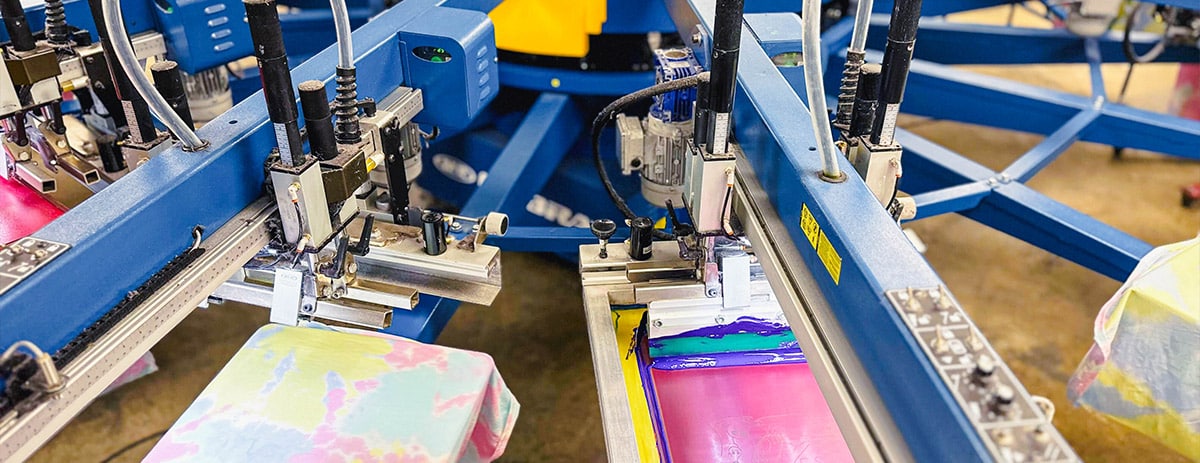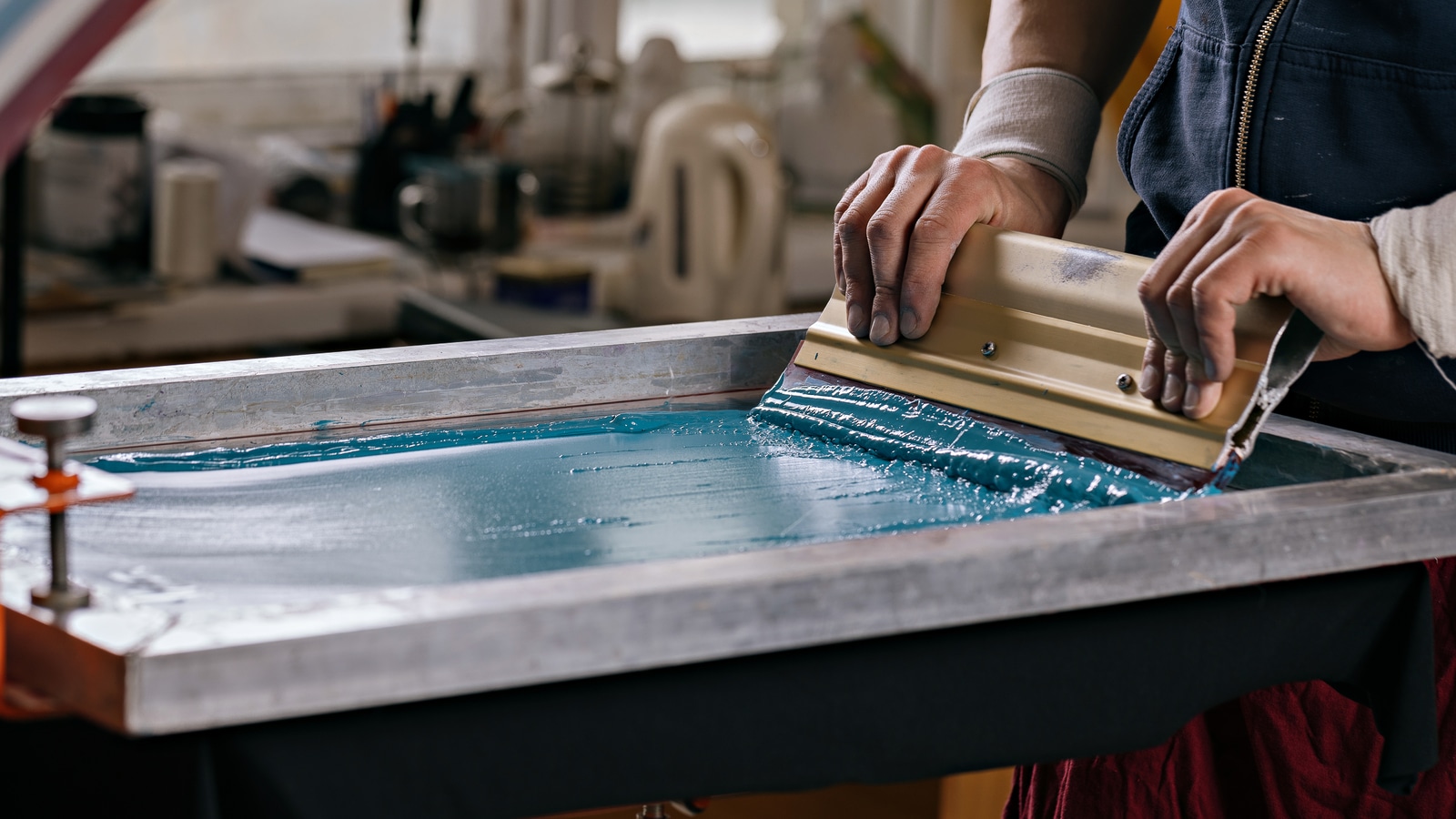High-Volume T-Shirt Printing for Schools and Organizations
Wiki Article
Screen Printing Uncovered: Every Little Thing You Need to Learn About T-Shirt and Garment Printing Techniques
If you have actually ever asked yourself exactly how those dynamic styles end up on your preferred tees, you're in the appropriate location. Display printing is an interesting method that integrates art with strategy, using limitless possibilities for creativity. Recognizing the principles, from devices to ink selections, can considerably influence your results. Prepared to explore the vital aspects that make display publishing an art kind? Let's reveal the information that can boost your projects.
The Basics of Display Printing: Exactly How It Functions
When you plunge into screen printing, you'll uncover it's both an art and a scientific research. At its core, display printing entails creating a stencil, or display, that permits ink to pass via just in specific locations.Next, you'll blend your inks and prepare your printing surface area. Placement the display over the material, then utilize a squeegee to press ink via the display onto the garment. This procedure calls for accuracy, as you want clear, lively prints. After printing, you'll treat the ink with heat, guaranteeing it abides by the material and lasts via washes. Each step is necessary, and understanding them will raise your display printing skills, transforming straightforward garments into distinct, meaningful pieces.
Sorts Of Screen Printing Strategies
When you comprehend the basics of display printing, it's time to discover the various techniques that can boost your styles. One prominent approach is standard display printing, where ink is pressed with a stenciled screen. This technique is fantastic for bold, vibrant colors. There's water-based ink printing, which offers a softer feel and is green, however it needs a various technique to healing.If you're intending for great information, take into consideration discharge printing. This strategy removes color from the fabric, leaving a soft, classic appearance. An additional option is plastisol printing, understood for its sturdiness and brilliant shades, making it a preferred for numerous brands. Experiment with halftone printing to produce gradient results and detailed styles. Each method has its distinct charm, so do not think twice to attempt them bent on discover what matches your style best!
Important Equipment for Display Printing
To accomplish stunning outcomes in screen printing, having the ideal devices is essential. You'll require a strong screen printing framework, which holds the mesh that transfers your layout onto the garment. Next, invest in high-quality squeegees; these are necessary for applying ink uniformly across the display.Choosing the Right Inks and Products
When picking inks and materials for screen printing, you require to take into account the kind of ink that works finest for your job. Think of fabric compatibility to assure your designs look last and terrific lengthy. Check out green ink alternatives to make your printing process more sustainable.Kinds Of Screen Inks
Picking the best display ink is vital for achieving vibrant, resilient prints that meet your project's requirements. There are a number of types of screen inks to check out. Specialized inks, such as glow-in-the-dark or metal, can add unique impacts to your designs.
Textile Compatibility Factors To Consider
Recognizing textile compatibility is essential for achieving top quality screen prints, especially given that various materials react distinctly to different inks. When choosing inks, think about the fabric type-- cotton, polyester, or blends. For cotton, water-based inks function well, providing gentleness and breathability. Polyester, on the other hand, frequently needs plastisol inks for far better attachment and dynamic colors. If you're printing on blends, you could require to use a mix of both kinds. Constantly test your inks on example material to ensure they adhere properly and maintain color honesty. Additionally, bear in mind that textile weight and texture can affect the final outcome, so choosing the appropriate ink and product combination is vital for your job's success.Eco-Friendly Ink Options
Green inks are coming to be a popular choice for display printers who desire to decrease their environmental effect while keeping quality. When picking inks, think about water-based inks, which are less harmful and simpler to cleanse up contrasted to traditional solvents.Furthermore, seek inks made from eco-friendly sources, such as soy or vegetable-based alternatives. By selecting the right inks and materials, you'll not just create magnificent styles yet additionally add to a much more sustainable printing process. Make the switch, and your prints will certainly show your commitment to the setting!
Preparing Your Design for Screen Printing

File Layout Requirements
To guarantee your design looks sharp and dynamic on material, you'll need to pay very close attention to submit format needs for screen printing. Begin with vector documents like AI or EPS, as they can be scaled without losing quality. If you use raster pictures, go with high-resolution files, such as TIFF or PNG, ideally at 300 DPI. Prevent utilizing JPEGs, as they can lose quality when resized. Make sure your design has a transparent background to prevent undesirable white edges on your prints. Maintain color settings in mind; CMYK is standard for display printing, so transform your RGB designs as necessary - screen printing kit. By adhering to these standards, you'll establish your artwork up for an effective print.Shade Separation Methods
Shade splitting up is a crucial action in preparing your design for screen printing, and understanding it can substantially boost your print quality. You'll need to damage your style right into specific shades, as each color needs a different screen throughout printing. Start by identifying all the colors in your layout and develop layers each. You can utilize software program like Adobe Photoshop or Illustrator to isolate and separate shades successfully. Be particular to conserve each layer as a separate data, typically in a layout like TIFF or PSD. This accuracy not just assures exact color depiction but additionally simplifies the printing procedure. By taking note of shade separation, you'll attain vibrant and expert lead to your screen-printed garments.Resolution and Dimension
Achieving the most effective outcomes in display printing starts with guaranteeing your design has the appropriate resolution and size. Ideally, your artwork should be at least 300 DPI (dots per inch) for sharp, clear prints. Your final product may look pixelated and amateur. if you make use of reduced resolution.When it comes to size, take into consideration the dimensions of your print area. Design your artwork to match the final print dimension, ideally developing it in the actual dimensions you'll be publishing. By doing this, you'll prevent any type of unforeseen scaling concerns.
Constantly check your style in both vector and raster styles. Vector graphics can be scaled without losing quality, making them perfect for screen printing. Preparing appropriately will ensure your style looks outstanding on every garment!
Step-by-Step Screen Printing Refine
Screen printing is a dynamic procedure that permits you to produce vibrant styles on different surfaces. To get started, you'll need a display, solution, and your picked ink.Put ink onto the display and make use of a squeegee to press the ink with the pattern onto the material. Lift the screen meticulously and let the print dry. You have actually effectively display published your style.
Tips for Successful Screen Printing Projects
While you're diving into your display printing jobs, keep in mind that preparation is essential to success. Beginning by gathering all your products-- inks, displays, garments, and squeegees. A clean work area aids avoid unwanted mistakes, so clean prior to you start.Next, verify your artwork is high-resolution and appropriately sized for your garment. Check your screen for appropriate exposure and tidy it thoroughly to prevent spots. When mixing your inks, follow the supplier's guidelines to attain the right uniformity.
Throughout printing, use even stress with your squeegee for constant outcomes. Don't rush; take your time to confirm each print fulfills your criteria. After printing, let your garments completely dry totally before managing or packaging them.
Last but not least, always keep an example of your benefit future referral. In this manner, you can examine your progress and enhance your techniques over time. Delighted printing!

Often Asked Concerns
The length of time Does It Require To Establish a Display Printing Job?
Establishing up a display printing task typically takes around half an hour to an hour. You'll prepare the displays, mix inks, and adjust the press. The time differs based upon intricacy and experience, so stay arranged!Can I Publish on Various Textile Types Using the Exact Same Technique?
Yes, you can print on different textile types utilizing the very same method, yet you'll require to adjust your setups and inks. Some fabrics soak up ink in a different way, so experimenting guarantees the very best results for every product.What Are Usual Blunders to Avoid in Display Printing?
When screen printing, prevent typical errors like utilizing the wrong ink, disregarding appropriate direct exposure times, or missing pre-press checks. Constantly test your setup and keep clean displays to ensure high quality results each time.How Can I Correctly Tidy and Keep My Display Printing Equipment?
To correctly tidy and keep your screen printing equipment, you need to frequently clean displays with proper solvents, check mops for wear, and guarantee all tools are stored dry and dust-free. Uniformity enhances and prevents costly repair services efficiency.Is Screen Printing Eco-friendly Contrasted to Other Approaches?
Screen printing can be extra eco-friendly than other techniques, particularly if you make use of eco-conscious products and water-based inks. By picking sustainable supplies and practices, you minimize waste and decrease your effect on the earth.Display Printing Uncovered: Every Little Thing You Required to Know Regarding Tee Shirt and Garment Printing Methods
At its core, screen printing entails producing a pattern, or screen, that allows ink to pass with only in details locations. Placement the screen over the textile, then use a squeegee to press ink via the screen onto the garment. One preferred method is typical screen printing, where ink is pushed with a stenciled display.When selecting inks and products for display printing, you require to take into account the type of ink that functions ideal for your task.
Report this wiki page